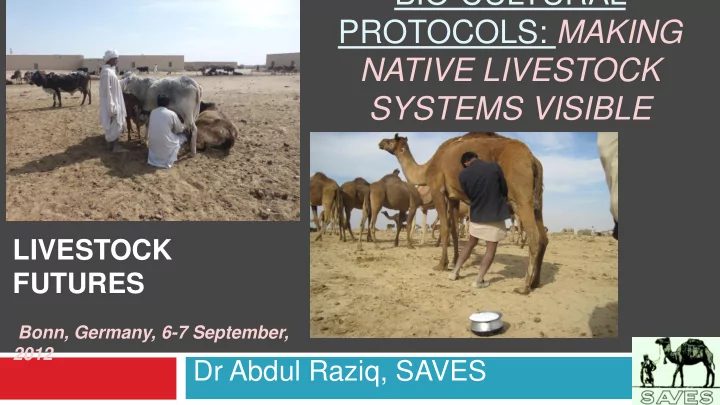

BIO-CULTURAL PROTOCOLS: MAKING NATIVE LIVESTOCK SYSTEMS VISIBLE LIVESTOCK FUTURES Bonn, Germany, 6-7 September, 2012 Dr Abdul Raziq, SAVES
OVERVIEW OF LIVESTOCK IN PAKISTAN Livestock contributes 51% of the agricultural GDP Pakistan is one of the largest milk producers globally (65-70% milk comes from buffalo) Red meat is produced entirely from native livestock production systems. Poultry is highly industrial and ever expanding. New frontiers of dairy as import of high yielding dairy cows and investment in dairy sector is increasing The present policies are in favor of industrial/commercial systems The role and importance of the native livestock production is not really valued, realized and appreciated.
NATIVE LIVESTOCK PRODUCTION SYSTEMS IN PAKISTAN Highly resilient and adaptable Resistant to challenges and shocks Depend on highly diversified resources (marginal lands, breeds, ecosystems etc) The system is very eco-friendly Multipurpose: produces diverse products and services Helps as biological control of weeds and parasites The system is part of culture, values, tradition, heritage, prestige and identity of community At the core of community institutions and the hub of indigenous knowledge
Biocultural protocols: silver lining in the clouds BCP documents and makes visible the role of communities: As custodian of native production systems and biodiversity at large As guardians of traditional breeds that are interdependent with the ecosystem; and As holders of traditional knowledge
METHODOLOGY AND PROCESS BCP work mainly based on documentation of production system, breeds, ecosystem, customary laws, products & its use Meeting with shepherds in the field, community elders, ethnoveterinarian and livestock keepers at large Literature, grey records to further fortify BCP
BCP PROCESS IN PAKISTAN Meeting with the community people at community level Discussed and documented production systems and livestock breeds Meeting with the experts/scientists, breeders, elders, ethnovets of the community Constitution of regional expert groups (REGs)
SEMINAR AND DECLARATION OF BCP Final meeting of the regional expert groups (REGs) and other representatives Discussion on the final version Declaration of the final version
OUTCOMES OF PASHTOON BCP Documentation of unknown breeds like Raigi camel and Kakari sheep breed etc Documented and valued the livestock products like Qourath, Landi etc Highlight the central role of Livestock keepers Highlight the contribution of native livestock production systems in food security A community document for its role and production systems Inform policy makers with this set of document about community role It makes livestock keepers aware of its rights under national laws and international treaties
COVER OF NATIONAL LAWS TO SECURE OUR RIGHTS National Conservation Strategy (NCS) addresses the conservation of natural resources and sustainable development Biodiversity Action Plan (2000): Promote the conservation and sustainable use of biodiversity, and the equitable sharing of benefits arising thereof, for the wellbeing and food security of the nation A CCESS TO B IOLOGICAL R ESOURCE AND C OMMUNITY R IGHTS , 2004; It recognizes the necessity “to protect and encourage cultural diversity, valuing the knowledge, innovations and practices of the local communities with respect to the conservation, management and use of biological resources
INTERNATIONAL TREATIES UN Convention on Biological Diversity, specifically under Article 8(j) of the Convention, to recognize our contribution to the conservation and sustainable use of biological diversity in the Balochistan forest/rangelands ecosystem. We also call on the UN Food and Agriculture Organization to acknowledge the importance of our animal genetic resources and to recognize livestock keepers’ rights
FURTHER READING http://pubs.iied.org/pd fs/G03404.pdf http://www.fao.org/do crep/013/i1823t/i1823 t13.pdf http://saves.org.pk/sit e/pub/401.pdf
Recommend
More recommend